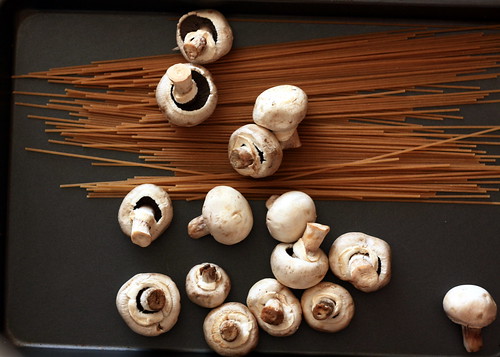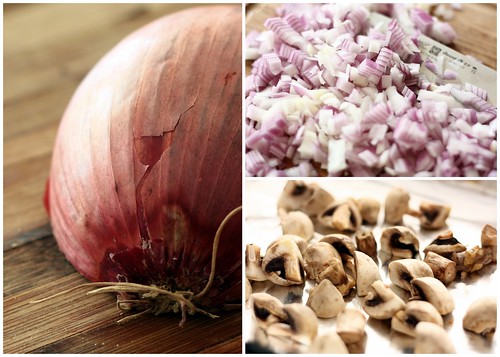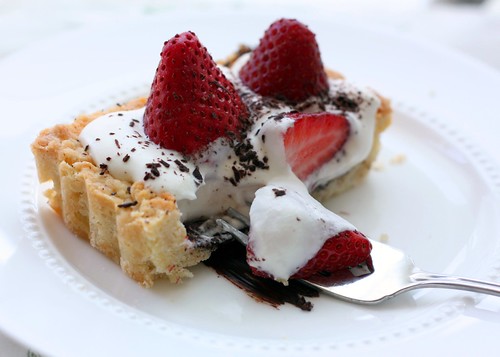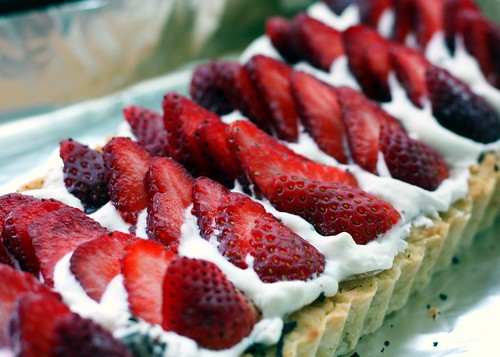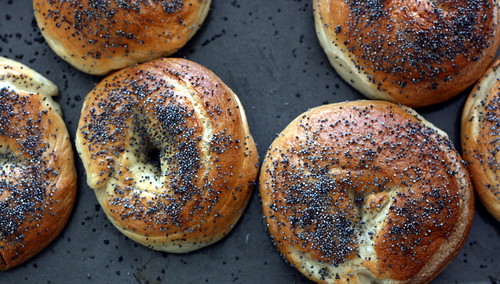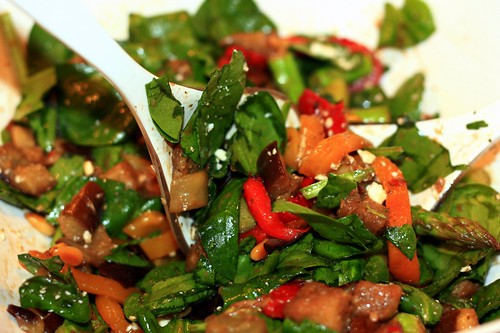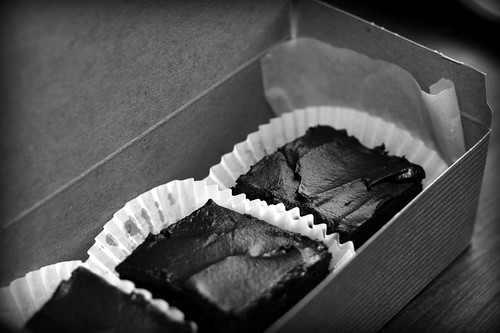I had already covered all the major sights and museums my first time there, so this time around, I just scribbled some markings on a map, took the subway to the Marais, and began walking. I think everyone should have a day like that, when they can just start walking, without regard to time, direction or destination, without being tethered to the cell phone or the blackberry (and also free to stop off at Gérard Mulot in St. Germain and get two, that's right, two pastries, thereby shocking the good sales-women of GM with my gluttony).
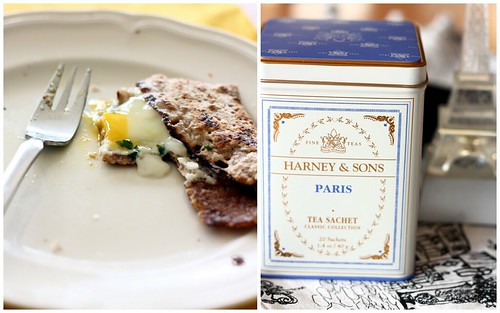 I had lunch in a small place on Ile Saint-Louis. The walls were painted red and the predominant language was French, and maybe it was the sunny day, but the waitress even smiled at me a few times and it seemed sincere. When I opened the menu and ordered a 3 course lunch for 10 Euro, I could hardly believe my eyes. I mean, 10 Euro, in Paris. I think my cafe creme and croissant in the morning were more than that. I was prepared to be disappointed. But you know where this story is heading, right? Disappointed I was not -- after all, it was Paris, the city of lights, magic and 10 Euro lunches. I can't say it was the best lunch I've ever had, but it was very decent, and even almost a year later, I can not stop thinking about the buckwheat galette that was my main course. With a runny egg and a sprinkling of cheese and herbs folded into a neat, square envelope, it was just light enough and substantial enough to carry me through until that fateful stop at Gérard Mulot.
I had lunch in a small place on Ile Saint-Louis. The walls were painted red and the predominant language was French, and maybe it was the sunny day, but the waitress even smiled at me a few times and it seemed sincere. When I opened the menu and ordered a 3 course lunch for 10 Euro, I could hardly believe my eyes. I mean, 10 Euro, in Paris. I think my cafe creme and croissant in the morning were more than that. I was prepared to be disappointed. But you know where this story is heading, right? Disappointed I was not -- after all, it was Paris, the city of lights, magic and 10 Euro lunches. I can't say it was the best lunch I've ever had, but it was very decent, and even almost a year later, I can not stop thinking about the buckwheat galette that was my main course. With a runny egg and a sprinkling of cheese and herbs folded into a neat, square envelope, it was just light enough and substantial enough to carry me through until that fateful stop at Gérard Mulot.  It took me a year to replicate the galette, mostly because I couldn't justify buying a bunch of buckwheat flour just for one indulgence. What finally tipped the scales was that I found a small bag of buckwheat hiding in my pantry, ground it up in my food processor, and I was ready to go. Well. Let's just say that I won't make the mistake of waiting another year to do this again! Compared to a regular crepe, the galette is heartier and nubby with delicious little bits of ground buckwheat, and is the perfect sturdy bed on which to rest your egg, ham, spinach, and of course, a sprinkling of cheese and herbs. And, it reminds me of Paris.
It took me a year to replicate the galette, mostly because I couldn't justify buying a bunch of buckwheat flour just for one indulgence. What finally tipped the scales was that I found a small bag of buckwheat hiding in my pantry, ground it up in my food processor, and I was ready to go. Well. Let's just say that I won't make the mistake of waiting another year to do this again! Compared to a regular crepe, the galette is heartier and nubby with delicious little bits of ground buckwheat, and is the perfect sturdy bed on which to rest your egg, ham, spinach, and of course, a sprinkling of cheese and herbs. And, it reminds me of Paris. Buckwheat galettes
This recipe comes from Clotilde at Chocolate and Zucchini, on of my favorite blogs from Paris. Being French, Clotilde automatically gets the monopoly on crepe and galette making, so I didn't mess with the proportions too much (except to convert to American measurements and decrease the amount of water by a little bit to make it easier to flip) or with any of her instructions (linked above and copied below). This makes quite a large quantity, so I halved the recipe when I was making it for myself. The quantities below are from Clotilde's original recipe. Please visit her website (chances are that you have already), as she is totally, totally awesome.
For the dough :
- 200 g (1.5 cups) buckwheat flour
- 50 g (1/3 cup) all-purpose flour
- 2 eggs
- 50 cl (2 cups) milk
- 25 cl (1 cup) water
For the galettes :
- salted butter
- the fillings of your choice
(Makes 12 medium galettes.)
Step 1 : Prepare the dough.
If you have a food processor , break the eggs in the bowl of the food processor. Add the flours, and mix until well blended. Add as much of the milk as your food processor allows and mix again. Transfer to a large mixing bowl, and add the remaining milk and the water. Whisk until thoroughly blended.
If you don't have a food processor, put the flour in a large mixing bowl and dig a little well in the center. Break the eggs in the well, and whisk them progressively into the flour in a circular motion. Pour the milk in slowly, whisking all the while. Add the water, still whisking.
In both cases, cover the mixing bowl with plastic wrap, and store in the fridge for at least two hours, overnight is best (Irene's note: *cough* I totally didn't, and they were still awesome).
Step 2 : Make the galettes.
Take the bowl of dough out of the fridge and prepare all the fillings beforehand. Whisk the galette dough again, as some of the flour will have settled at the bottom of the bowl.
If you're making several galettes in a row, preheat the oven to 180°C (360°F). This is where you'll keep the galettes warm while you make the others.
Heat up a large non-stick skillet over high heat. When it is very hot, put in a sliver of salted butter. When it is melted, but before it browns, use a paper towel to (cautiously) spread the butter evenly on the surface of the skillet. Pour a ladleful of dough (Irene's note: about 1/2 - 3/4 cup per galette) in the skillet, and swoop the skillet around so that the dough spreads out in a nice even circle. Let cook on medium-high heat for a few minutes, peeking underneath with a spatula from time to time to check on the cooking.
Flip the galette when it's nicely golden underneath, cautiously or brazenly depending on your self-assurance. Put the fillings of your choice in the center of the galette. If using an egg, break it cautiously and gently maintain the yolk in the center with the eggshell or your spatula until the white has set enough to hold it in place. When the other side of the galette is nice and golden too, fold it as best you can : the traditional way is to fold the four sides in and make a square galette, but when there's a lot of filling and the galette isn't very big that's a little difficult, so just fold two sides in.
Put the galette in a large baking dish or on a cookie sheet and into the oven to keep warm while you make the others. Serve with a green salad and liberal amounts of Cidre Brut, an alcoholic apple cider from Brittany.





